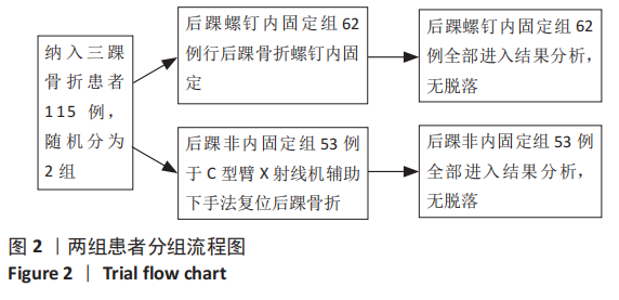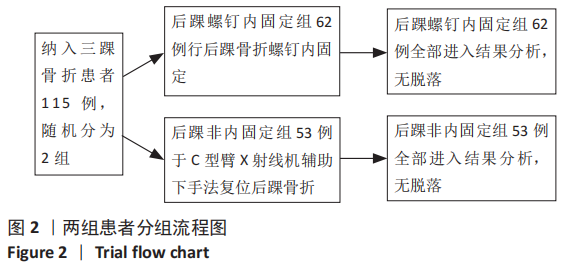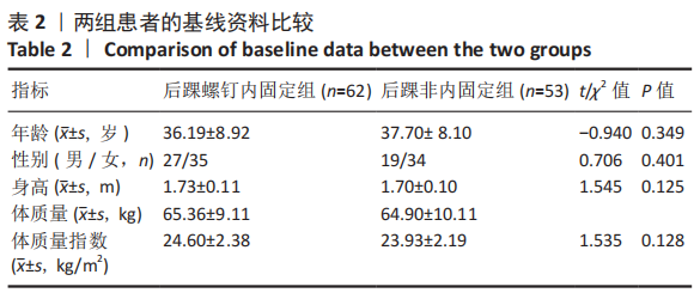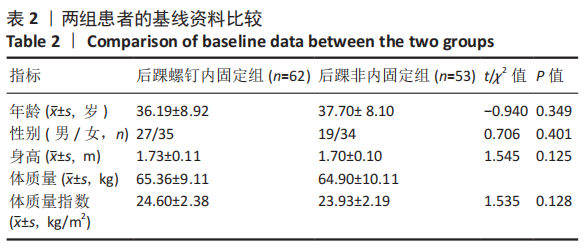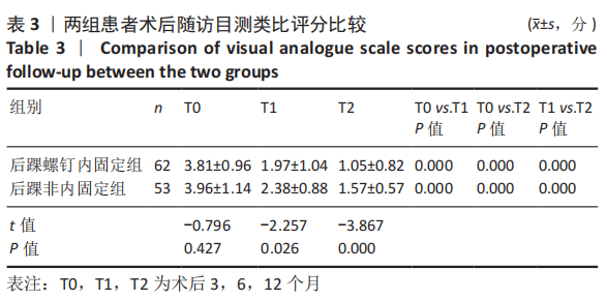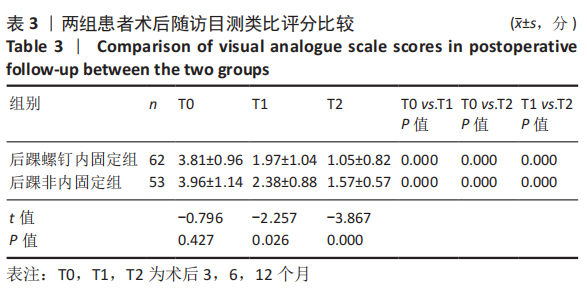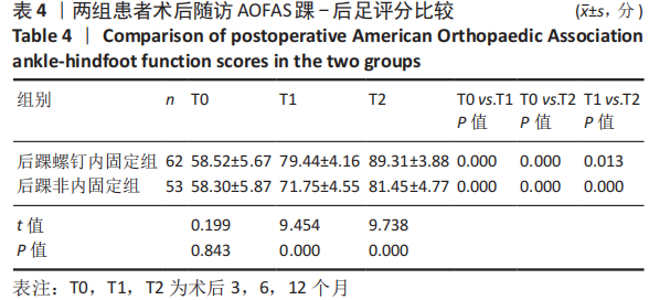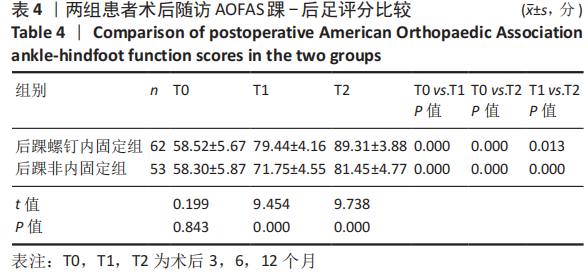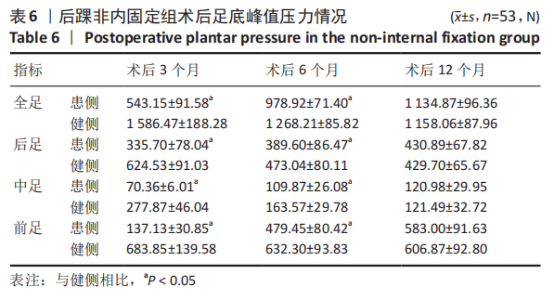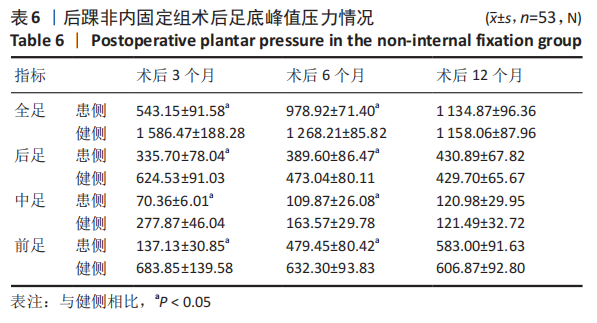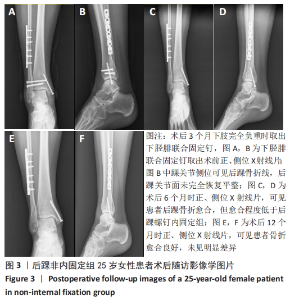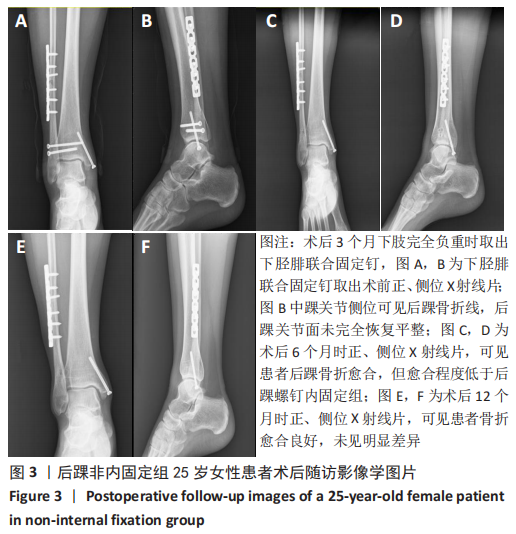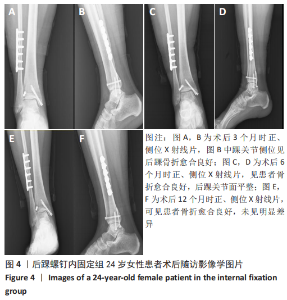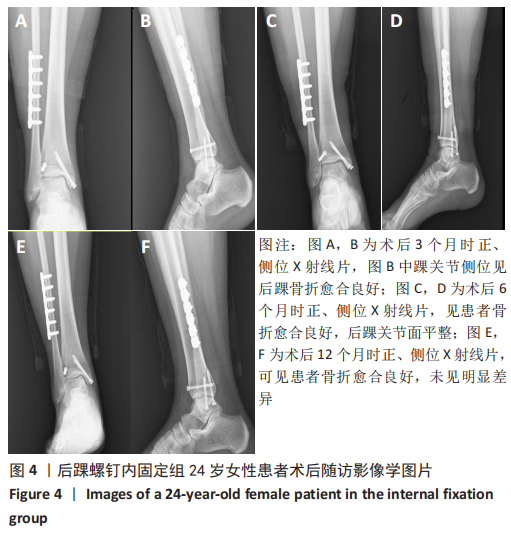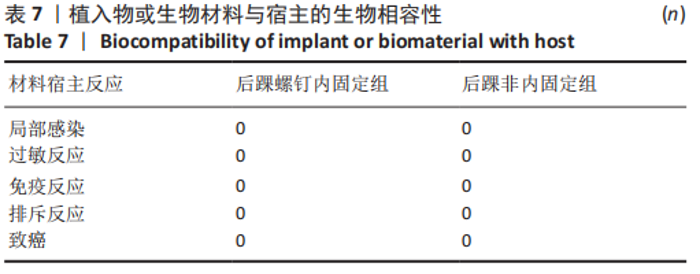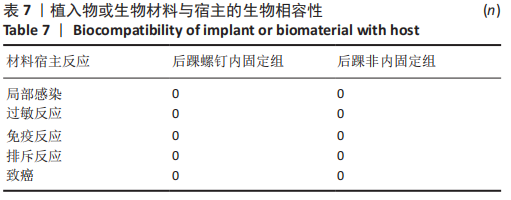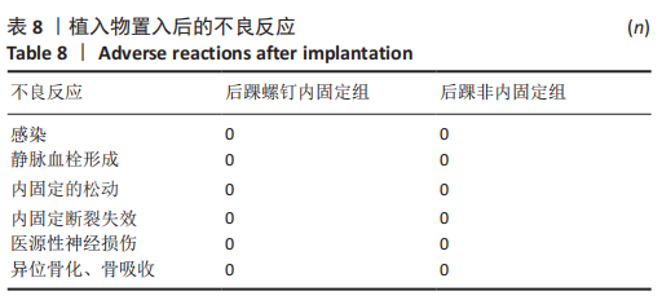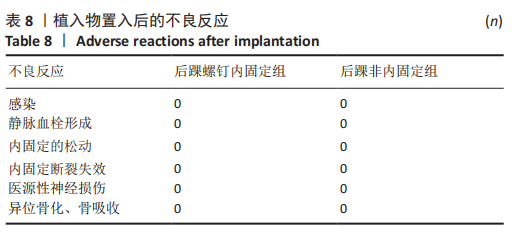Chinese Journal of Tissue Engineering Research ›› 2021, Vol. 25 ›› Issue (27): 4379-4385.doi: 10.12307/2021.200
Previous Articles Next Articles
Screw internal fixation and conservative treatment of posterior ankle fractures: differences in ankle joint function and plantar pressure
He Yi, Zheng Cong, He Minhui, Lu Ruijun, Huang Jianrong
- Department of Orthopedics, The Fifth Affiliated Hospital of Guangzhou Medical University, Guangzhou 510000, Guangdong Province, China
-
Received:2020-10-14Revised:2020-10-17Accepted:2020-11-21Online:2021-09-28Published:2021-04-10 -
Contact:Huang Jianrong, MD, Chief physician, Department of Orthopedics, The Fifth Affiliated Hospital of Guangzhou Medical University, Guangzhou 510000, Guangdong Province, China -
About author:He Yi, MD, Attending physician, Department of Orthopedics, The Fifth Affiliated Hospital of Guangzhou Medical University, Guangzhou 510000, Guangdong Province, China
CLC Number:
Cite this article
He Yi, Zheng Cong, He Minhui, Lu Ruijun, Huang Jianrong. Screw internal fixation and conservative treatment of posterior ankle fractures: differences in ankle joint function and plantar pressure[J]. Chinese Journal of Tissue Engineering Research, 2021, 25(27): 4379-4385.
share this article
Add to citation manager EndNote|Reference Manager|ProCite|BibTeX|RefWorks
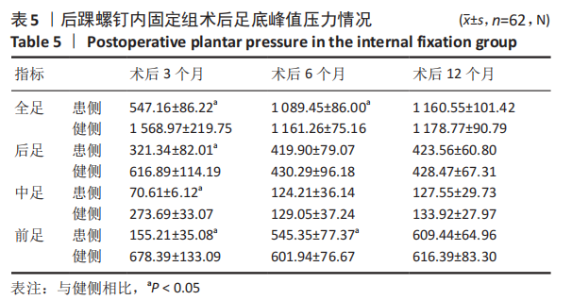
经配对样本t检验,术后3个月(T0),两组患者的AOFAS踝-后足评分相比差异无显著性意义(P > 0.05);术后6个月(T1)及12个月(T2)时,后踝螺钉内固定组的AOFAS踝-后足评分明显高于后踝非内固定组(P < 0.05)。 经重复测量检验,术后3个月(T0)、6个月(T1)及12个月(T2)时,两组患者AOFAS踝-后足评分均呈升高趋势,组间相比差异有显著性意义(后踝螺钉内固定组:F=712.916,P=0.000;后踝非内固定组:F=275.932,P=0.000)。 2.6 两组患者术后足底压力情况 两组患者术后足底压力情况分别见表5,6。 经配对样本t检验,术后3个月时,后踝螺钉内固定组与后踝非内固定组足底压力显著不平衡,患侧足足底压力(全足、后足、中足、前足)显著低于健侧足(P < 0.05)。 术后6个月时,后踝螺钉内固定组患侧足的全足、前足的足底压力仍低于健侧足 (P < 0.05);但其后足、中足的足底压力与健侧差异无显著性意义(P > 0.05)。后踝非内固定组患侧足足底压力(全足、后足、中足、前足)仍显著低于健侧足 (P < 0.05)。 术后12个月时,两组患者患侧与健侧足的足底压力均趋于平衡,患侧足足底压力(全足、后足、中足、前足)与健侧足相比差异无显著性意义(P > 0.05)。 "
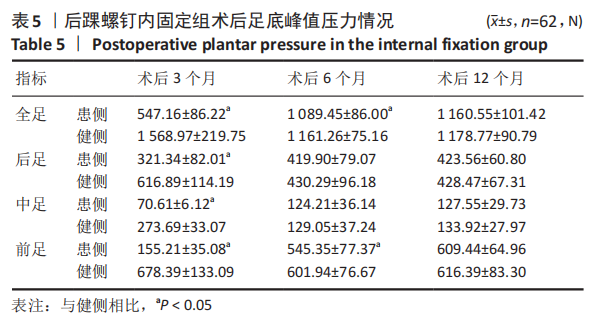
| [1] KOVAL KJ, LURIE J, ZHOU W, et al. Ankle fractures in the elderly: What you get depends on where you live and who you see. J Orthop Trauma. 2005;19:635-639. [2] JASKULKA RA, ITTNER G, SCHEDL R. Fractures of the posterior tibial mar gin: Their role in the prognosis of malleolar fractures. J Trauma. 1989;29:1565-1570. [3] VERHAGE SM, BOOT F, SCHIPPER IB, et al. Open reduction and internal fixation of posterior malleolar fractures using the posterolateral approach. Bone Joint J. 2016;98-B(6):812-817. [4] VAN DEN BEKEROM MP, HAVERKAMP D, KLOEN P. Biomechanical and clinical evaluation of posterior malleolar fractures. A systematic review of the literature. J Trauma. 2009;66:279-284. [5] DRIJFHOUT VAN HOOFF CC, VERHAGE SM, HOOGENDOORN JM. Influence of fragment size and postoperative joint congruency on long-term outcome of posterior malleolar fractures. Foot Ankle Int. 2015;36; 673-678. [6] XU HL, LI X, ZHANG DY, et al. A retrospective study of posterior malleolus fractures. Int Orthop. 2012;36:1929-1936. [7] TOSUN B, SELEK O, GOK U, et al. Posterior Malleolus Fractures in Trimalleolar Ankle Fractures: Malleolus versus Transyndesmal Fixation. Indian J Orthop. 2018;52(3):309-314. [8] EVERS J, BARZ L, WÄHNERT D, et al. Size matters: The influence of the posterior fragment on patient outcomes in trimalleolar ankle fractures. Injury. 2015;46 Suppl 4:S109-S113. [9] NELSON MC, JENSEN NK. The treatment of trimalleolar fractures of the ankle. Surg Gynecol Obst. 1940;71:509-514. [10] DRIJFHOUT VAN HOOFF CC, VERHAGE SM, et al. Influence of Fragment Size and Postoperative Joint Congruency on Long-Term Outcome of Posterior Malleolar Fractures. Foot Ankle Int. 2015;36(6):673-678. [11] EGOL KA, TEJWANI NC, WALSH MG, et al. Predictors of short-term functional outcome following ankle fracture surgery. J Bone Joint Surg Am. 2006;88(5):974-979. [12] KEENE DJ, COSTA ML, TUTTON E, et al. Progressive functional exercise versus best practice advice for adults aged 50 years or over after ankle fracture: protocol for a pilot randomised controlled trial in the UK - the Ankle Fracture Treatment: Enhancing Rehabilitation (AFTER) study. BMJ Open. 2019;9(11):e030877. [13] BECKER HP, ROSENBAUM D, KRIESE T, et al. Gait asymmetry following successful surgical treatment of ankle fractures in young adults. Clin Orthop Relat Res. 1995;(311):262-269. [14] MASON LW, KAYE A, WIDNALL J, et al. Posterior Malleolar Ankle Fractures: An Effort at Improving Outcomes. JB JS Open Access. 2019;4(2):e0058. [15] MANGNUS L, MEIJER DT, STUFKENS SA, et al. Posterior malleolar fracture patterns. J Orthop Trauma. 2015;29(9):428-435. [16] GARDNER MJ, BRODSKY A, BRIGGS SM, et al. Fixation of posterior malleolar fractures provides greater syndesmotic stability. Clin Orthop Relat Res. 2006;447:165-171. [17] VAN DEN BEKEROM MP, HAVERKAMP D, KLOEN P. Biomechanical and clinical evaluation of posterior malleolar fractures. A systematic review of the literature. J Trauma. 2009;66(1):279-284. [18] LANGENHUIJSEN JF, HEETVELD MJ, ULTEE JM, et al. Results of ankle fractures with involvement of the posterior tibial margin. J Trauma. 2002;53:55-60. [19] MINGO-ROBINET J, LOPEZ-DURAN L, GALEOTE JE, et al. Ankle fractures with posterior malleolar fragment: management and results. J Foot Ankle Surg. 2011;50:141-145. [20] GONZALEZ TA, WATKINS C, DRUMMOND R, et al. Transfibular Approach to Posterior Malleolus Fracture Fixation: Technique Tip. Foot Ankle Int. 2016;37(4):440-445. [21] CHOI JY, KIM JH, KO HT, et al. Single Oblique Posterolateral Approach for Open Reduction and Internal Fixation of Posterior Malleolar Fractures With an Associated Lateral Malleolar Fracture. J Foot Ankle Surg. 2015; 54(4):559-564. [22] 万全会.后踝关节骨折不同内固定方式的生物力学性能对比[J].中国组织工程研究,2015,19(48):7806-7810. [23] KANG C, HWANG DS, LEE JK, et al. Screw Fixation of the Posterior Malleolus Fragment in Ankle Fracture. Foot Ankle Int. 2019;40(11): 1288-1294. [24] MARTIN KD. Posterior Arthroscopic Reduction and Internal Fixation for Treatment of Posterior Malleolus Fractures. Foot Ankle Int. 2020; 41(1):115-120. [25] VIDOVIĆ D, ELABJER E, MUŠKARDIN IVA, et al. Posterior fragment in ankle fractures: anteroposterior vs posteroanterior fixation. Injury. 2017;48 Suppl 5:S65-S69. [26] HOEKSTRA H, ROSSEELS W, RAMMELT S, et al. Direct fixation of fractures of the posterior pilon via a posteromedial approach. Injury. 2017;48(6):1269-1274. [27] KARIM A, SO E, TAYLOR BC, et al. Ankle Fracture Fixation: Medial or Lateral First? J Foot Ankle Surg. 2019;58(1):75-79. [28] OʼCONNOR TJ, MUELLER B, LY TV, et al. “A to p” screw versus posterolateral plate for posterior malleolus fixation in trimalleolar ankle fractures. J Orthop Trauma. 2015;29(4):e151-156. [29] PALMANOVICH E, OHANA N, YAACOBI E, et al. Preoperative planning and surgical technique for optimizing internal fixation of posterior malleolar fractures: CT versus standard radiographs. J Orthop Surg Res. 2020;15(1):119. [30] ERDEM MN, ERKEN HY, BURC H, et al. Comparison of lag screw versus buttress plate fixation of posterior malleolar fractures. Foot Ankle Int. 2014;35(10):1022-1030. |
| [1] | Wang Jianping, Zhang Xiaohui, Yu Jinwei, Wei Shaoliang, Zhang Xinmin, Xu Xingxin, Qu Haijun. Application of knee joint motion analysis in machanism based on three-dimensional image registration and coordinate transformation [J]. Chinese Journal of Tissue Engineering Research, 2022, 26(在线): 1-5. |
| [2] | Li Canhui, Wu Zhengjie, Zeng Yanhui, He Yinghao, Situ Xiaopeng, Du Xuelian, Hong Shi, He Jiaxiong. Advantage and disadvantage of robot-assisted sacroiliac screw placement and traditional fluoroscopy in orthopedic surgery [J]. Chinese Journal of Tissue Engineering Research, 2022, 26(9): 1434-1438. |
| [3] | Yuan Jiabin, Zhu Zongdong, Tang Xiaoming, Wei Dan, Tan Bo, Xiao Chengwei, Zhao Ganlinwei, Liao Feng. Classification and reduction strategies for irreducible intertrochanteric femoral fracture based on anatomy [J]. Chinese Journal of Tissue Engineering Research, 2022, 26(9): 1341-1345. |
| [4] | Zhang Yufang, Lü Meng, Mei Zhao. Construction and verification of a full spine biomechanical model of adolescent scoliosis [J]. Chinese Journal of Tissue Engineering Research, 2022, 26(9): 1351-1356. |
| [5] | Bai Zixing, Cao Xuhan, Sun Chengyi, Yang Yanjun, Chen Si, Wen Jianmin, Lin Xinxiao, Sun Weidong. Construction and biomechanical analysis of ankle joint finite element model in gait cycle [J]. Chinese Journal of Tissue Engineering Research, 2022, 26(9): 1362-1366. |
| [6] | Liu Feng, Feng Yi. Finite element analysis of different Kirschner wire tension bands on transverse patella fractures during gait cycle [J]. Chinese Journal of Tissue Engineering Research, 2022, 26(9): 1367-1371. |
| [7] | Pan Baoshun, Fang Zhen, Gao Mingjie, Fang Guiming, Chen Jinshui. Design for posterior atlantoaxial internal fixation system with fusion cage based on imaging data [J]. Chinese Journal of Tissue Engineering Research, 2022, 26(9): 1372-1376. |
| [8] | Li Kun, Gao Erke, Xiong Feng, Wang Xing, Wu Danqi, Li Zhijun, Zhang Shaojie, Liu Yanan, Duo Lan, Li Ziyu. Feasibility of axial transpedicle screw internal fixation in children aged 1 to 6 years [J]. Chinese Journal of Tissue Engineering Research, 2022, 26(9): 1383-1387. |
| [9] | Song Yuxin, Zhang Tongtong, Niu Jianxiong, Wang Zengping, Wen Jie, Zhang Qunli, Xue Wen, Liu Lin. Precise screw placement of 3D printing model and orthopedic robot in spinal deformity [J]. Chinese Journal of Tissue Engineering Research, 2022, 26(6): 904-907. |
| [10] | Yang Jun, Yang Qun, Zhang Rui, Jiang Chang. A novel slidable pedicle screw-rod system for lumbar tuberculosis: promoting bone graft fusion by producing stress stimulation to fused segment [J]. Chinese Journal of Tissue Engineering Research, 2022, 26(6): 914-918. |
| [11] | Guo Xiaohui, Song Xizheng, Xiang Hanrui, Kang Zhaorong, Li Daming, Kang Yu, Hu Jun, Sheng Kai. External spinal fixation elastic stress in the treatment of jumping spinal fracture [J]. Chinese Journal of Tissue Engineering Research, 2022, 26(6): 919-923. |
| [12] | Duan Chao, Shang Xiaoqiang, Duan Xianglin, Yang Ping, Tao Shengxiang. Stability of patellar claw versus loop plate combined with patellar claw for the treatment of comminuted fractures of the lower pole of the patella [J]. Chinese Journal of Tissue Engineering Research, 2022, 26(6): 934-937. |
| [13] | Zhang Xinlong, Ci Wentao, Luo Kaiwen, Yan shi. Internal fixation failure after proximal femoral nail antirotation: causes and reoperation strategies [J]. Chinese Journal of Tissue Engineering Research, 2022, 26(6): 973-979. |
| [14] | Wen Mingtao, Liang Xuezhen, Li Jiacheng, Xu Bo, Li Gang. Mechanical stability of Sanders II type calcaneal fractures fixed by two internal fixation methods [J]. Chinese Journal of Tissue Engineering Research, 2022, 26(6): 838-842. |
| [15] | Huang Hao, Hong Song, Wa Qingde. Finite element analysis of the effect of femoral component rotation on patellofemoral joint contact pressure in total knee arthroplasty [J]. Chinese Journal of Tissue Engineering Research, 2022, 26(6): 848-852. |
| Viewed | ||||||
|
Full text |
|
|||||
|
Abstract |
|
|||||
